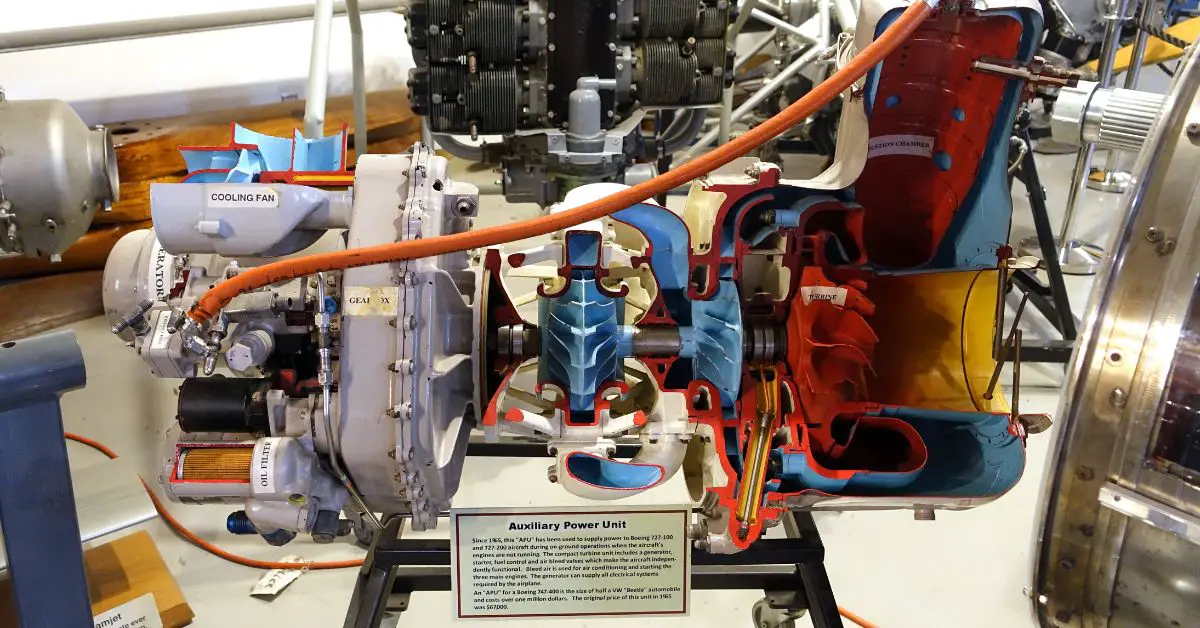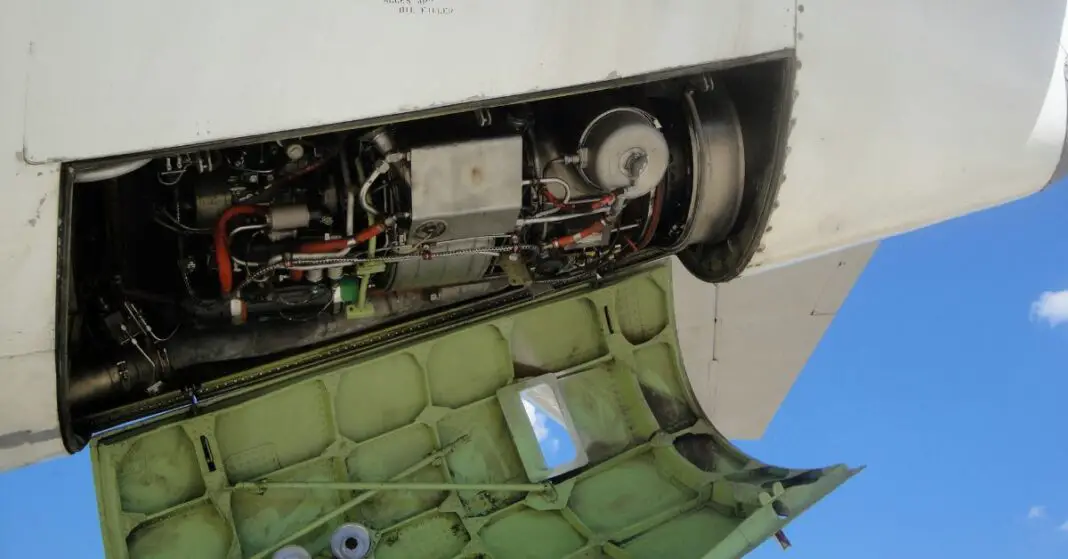Have you ever wondered about that small but important thing on planes that isn’t for flying but makes your trip better? Well, that’s what we’re talking about – the Auxiliary Power Unit (APU). We’ll explore what it does, how it works, and why it’s important for your journey in the sky.
Table of Contents
Fundamentals of Auxiliary Power Unit (APU)
The Auxiliary Power Unit (APU) – perhaps one of the unsung heroes in the complex ecosystem that constitutes an aircraft. Its role, while commonly overlooked by the general public, is indeed, indispensable to the smooth, effective operation of an aircraft. These formidable workhorses deserve recognition for their contribution to the aviation sector, for without them, planes would hardly, ever reach into the resplendent blue above.
The principal purpose of an Auxiliary Power Unit (APU) is remarkably straightforward; it provides energy for functions other than propulsion. This energy, undeniably vital to any aircraft, powers diverse operations, such as starting the main engines, running air conditioning within the cabin, and energizing the planeload electrical system when the engines are inactive.
Starting the main engines is no small task. As a matter of fact, the nature of a jet engine requires its turbine to be in constant motion before fuel can be applied for ignition. It is the humble APU that provides the power to launch these turbines into rotation, a task it undertakes with an unwavering sense of commitment, much like the collective dedication of the crew on every flight.
Air conditioning, often taken for granted, is another function powered by the trusty APU. In the closed environment of an aircraft cabin, it’s crucial to maintain a regulated temperature for passenger comfort and safety. It is this duty that is entrusted to the APU, a major player in the provision of a comfortable flight experience.
The electrical function is yet another significant APU role. Particularly on the ground, when the main engines are off, it’s the APU that steps in to keep the aircraft’s electrical system fully operational – a safety net that’s essential during those inevitable moments of engine shutdown.
In summary, the Auxiliary Power Unit undertakes various roles indispensable to the functionality of an aircraft. Whether it’s prepping the aircraft for takeoff, regulating cabin temperature, or keeping the electrical system chugging along, the APU performs these tasks with an unassuming, relentless efficiency.
Its behind-the-scenes role is integral to the operation and safety of every flight, underscoring the powerful truth that in the mechanics of aviation, every cog serves a meaningful purpose. Thus, the invaluable contribution of the APU to modern aircraft technology is unequivocally established, transmuting an unsung hero into a true champion of the skies.
Operational Mechanism of the APU
Coursing through the quintessential functions of an Auxiliary Power Unit (APU), we now dive into the comprehensive realm of its operational mechanics, unraveling the intricate efficiency it instills in the heart of the aircraft’s performance.
To decipher the operation of an APU, it is imperative to explore its core components. An APU can be divided into three key sections: power section, load compressor, and accessory drive. The power section, fundamentally a gas turbine engine, propels the APU. The accessory drive is tasked with transmitting power from the gas turbine engine to the load compressor.
The load compressor, a critical component, directs compressed air flow for different applications, including starting the main engines and powering the cabin air-conditioning system. Its function remains crucial to instill comfort and reliability, especially in specific situations like the intensified air pressure at high altitudes.
In essence, the operation of an APU is a well-choreographed dance between these components where the gas turbine engine creates a mechanical action, that, in turn, powers the load compressor through the accessory drive.
The APU uses a mixture of fuel and air gleaned from the aircraft fuel tanks and external compressed air respectively. These undergo a combustion process within the power section – a transformative journey invigorating the conversion of chemical energy into mechanical energy, powering the APU.
An essential but understated marvel of the APU is its self-sustenance. Post the initial spark aided externally to kick start the combustion process, the APU requires no external assistance and maintains its operation independently, a boon during long-haul flights.

Understandably, the cooling of the APU is a crucial requirement to ensure the system functions optimally and prevent overheating. This is achieved through a continuous supply of cool air pulled in from the exterior environment, assuring a safeguard against possible thermal damage.
Diving even deeper, the effectiveness of the APU transcends beyond the physical boundaries of an aircraft. Ground operations, right from cabin preparation to pre-flight checks, all vastly depend on the seamless functioning of the APU, setting the tone for a reliable and efficient flight.
To emphasize, in many ways, the APU is quietly serving as an unsung hero on a flight journey. It remains a testament to the marvels of engineering, diligently operating behind the scenes to contribute significantly to the aircraft’s performance and passenger comfort. A symbol of independence and reliability, the APU is indeed an integral entity in modern aircraft systems.
Evolution and Advancements in APU Technology
To contextualize the importance of Auxiliary Power Units (APU), one must delve into their historicity. In the early stages of the aviation industry, aircraft systems used mechanical power provided by the aircraft’s engines. However, with technological advancements, aircraft systems started to rely on electrical power, necessitating an alternative source – thus marking the inception of APUs.
The earliest iterations of APUs, mainly used in military aircraft during World War II, were elementary and functioned reservedly to start the aircraft’s engines. As technologies improved, and commercial aviation demanded more versatility, APUs evolved into sophisticated units capable of providing electricity, pneumatics, and hydraulic power, thereby ensuring safer aircraft operations both on the ground and in-flight.
During the 1950s and 60s, the jet age amplified the need for APUs as the power requirements of modern aircraft outstripped the capabilities of battery-powered systems. Early jet airliners, like the Boeing 707, made use of APUs to power systems when engines weren’t running – a quantum leap in aviation technology.
The jet age also solidified the APU’s role as an indispensable backup power source. By the 1980s, APUs became lighter, smaller, and more efficient – thanks to innovations in turbine engine technology and material science.
The modern-day developments in APU technology primarily focus on efficiency, reliability, and environmental consciousness. The APUs designed today are substantially more compact and lightweight, yet offer superior performance than their predecessors. They are also created with a greater emphasis on fuel efficiency and resource conservation, reflecting the industry’s pivot towards sustainable aviation.
Notably, significant strides have been made in reducing the noise and emissions from APUs with advancements in combustion technology. Modern APUs adhere to stringent emissions standards set by international aviation governing bodies, exemplifying the industry’s commitment to greener aviation practices.
Safety Considerations and Emergency Usage of APU
Delving into the safety nexus of APUs, several integral components commence to surface, each steeped in its unique pantheon of safety standards and regulations. At the forefront lies the Fire Detection and Suppression System. In essence, this mechanism acts as a sentinel for any abrupt temperature increases that could result in an APU fire, triggering systems in place to suppress such an incident.
APUs are caisson, commonly at the tail of the aircraft, in a dedicated compartment entrenched with firewalls. These firewalls are designed to withstand extreme temperatures providing an additional layer of safety, averting the propagation of potential fires to other components of the aircraft.
The safety and control system of an APU extends to numerous layers. Engine control units (ECU) are substantial constituents leveraging precision in microprocessor technology to monitor and control fuel metering, ignition timing, and other critical parameters. Provisions for automatic shutdown of APUs in incidents concerning high temperatures or speeding further clarify the substantial role of APUs in upholding safety measures.
Moving towards more emergency situations, APUs hold the capacity to function as an autonomous source of power in flight, in the midst of catastrophic engine failures. This facilitates the continuation of critical operations such as powering flight control systems and cabin pressurization, granting pilots a commendable time window for arranging a secure landing.
The effectiveness of an APU during an emergency landing or evacuation cannot be overstated. It lends power to exit lights and illuminations, reinforcing navigation for passengers throughout a potentially chaotic scenario. This role significantly amplifies the importance of an effectively functioning APU during crisis scenarios and thus, its inherent connection to safety measures.
Finally, APUs generously contribute to ground safety by reducing the necessity for ground power units and air start units, thereby curtailing congestion on the ramp, lowering the risk of collisions, and greatly depreciating the risk of ground personnel being exposed to the hazards associated with these operations. Furthermore, the APU continues supplying conditioned air, ensuring comfortable cabin temperatures during boarding and disembarkation.
What is the auxiliary system of an aircraft?
A plane has a small engine called the auxiliary power unit (APU). It starts working when the main engines are off. This onboard power source makes electricity and compressed air. It helps with things like lights, air conditioning, brakes, and de-icing when the plane is on the ground. It also helps start the main engines. The APU makes sure everything runs smoothly and safely before the plane takes off and after it lands.
What is the APU on an aircraft responsible for?
The Auxiliary Power Unit (APU) in an airplane is similar to a small, built-in power plant. It offers necessary services when the main engines are not running or during taxiing and ground operations. Picture it as the plane’s “tiny engine” that ensures everything works well before takeoff and after landing.
What is the function of auxiliary power?
An APU is a little engine on board that supplies electrical power and compressed air to an aircraft when the main engines are not running or during ground operations. This enables essential systems like lighting, air conditioning, and engine starting to work independently without depending on external power sources.
Can a plane fly without an APU?
While it’s not super necessary for flying, the APU is really important for keeping everyone comfy and making things easy for both passengers and the crew.
What happens to an aircraft if the APU fails?
If the APU (Auxiliary Power Unit) of an aircraft fails, it typically doesn’t affect the safety of the flight itself. The APU is mainly responsible for providing electrical power and compressed air for various systems when the main engines are not running, such as during ground operations.
Is APU turned on during flight?
Typically, the APU is not activated while the aircraft is in flight. Once the plane reaches its cruising altitude, the main engines become sufficient to supply the required electricity and compressed air for the aircraft’s systems. Running the APU during flight is not needed and is actually avoided because it consumes extra fuel and generates additional noise.





